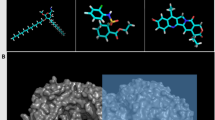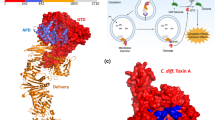Abstract
Objective
Colorectal cancer (CRC) is the third leading cause of cancer-related deaths in both men and women. Toll-like receptor 5 (TLR5), an autoimmune signaling receptor that plays a role in cancer, can be exploited for the suppression of human colon cancer. Salmonella flagellin protein, a novel agonist of TLR5 activating downstream signaling, could be a basis for designing anticancer peptides.
Methods
The three-dimensional crystal structure of TLR5 (PDB ID: 3J0A, Resolution = 26.0 Å) was optimized using the AMBER force field in the YASARA suit. In silico enzymatic digestion tool, PeptideCutter, was used to identify peptides from Salmonella flagellin, an agonist against human TLR5. The 3D structure of the peptides was generated using PEP-FOLD3. These peptides were screened against human TLR5 using shape complementarity principles based on the binding affinity and interactions with the active residue of TLR5 monomer, and the selected peptides were further validated by molecular dynamic (MD) simulation.
Results
In this study, we generated 42 peptides from Salmonella flagellin protein by in silico protein digestion. Then, based on a new hidden Markov model sub-optimal conformation sampling approach as well as the size of the fragments, we select 38 effective peptides from these 42 cleavages. These peptides were screened against the monomeric Xray structure of human TLR5 using shape complementarity principles. Based on the binding affinity and interactions with the active residue of TLR5 monomer (residues 294 and 366 of TLR5), nine top-scored peptides were selected for the initial molecular dynamic (MD) simulation. Among these peptides, Clv10, Clv17, and Clv28 showed high stability and less flexibility during MD simulation. A 1 μs MD simulation was performed on TLR5-Clv10, TLR-Clv17, and TLR5-Clv28 complexes to further analyze the stability, conformational changes, and binding mode (Clv10, Clv17, and Clv28). During this MD study, the peptides showed high salt bridges and ionic interactions with residue ASP294 and residue ASP366 throughout the simulation and remained in the concave of the human TLR5 monomer. The RMSD and Rg values showed that the peptide-protein complexes become stable after 200 ns of contraction and extraction.
Conclusion
These findings can facilitate the rational design of selected peptides as an agonist of TLR5, which have antitumor activity, suppress colorectal cancer tumors, and can be used as promising candidates and novel agonists of TLR5.
Graphical Abstract









Similar content being viewed by others
Data Availability
The data generated in this study are available from the corresponding author upon reasonable request.
References
Favoriti P, Carbone G, Greco M, Pirozzi F, Pirozzi REM, Corcione F (2016) Worldwide burden of colorectal cancer: a review. Updates Surg 68(1):7–11. https://doi.org/10.1007/s13304-016-0359-y
Yoon S et al (2012) Structural basis of TLR5-flagellin recognition and signaling. Science 335(6070):859–864. https://doi.org/10.1126/science.1215584
Song WS, Jeon YJ, Namgung B, Hong M, Yoon S (2017) A conserved TLR5 binding and activation hot spot on flagellin. Sci Rep 7(January):1–11. https://doi.org/10.1038/srep40878
Rhee SH, Im E, Pothoulakis C (2008) Toll-like receptor 5 engagement modulates tumor development and growth in a mouse xenograft model of human colon cancer. Gastroenterology 135(2):518–528. https://doi.org/10.1053/j.gastro.2008.04.022
Leigh ND et al. (2014) A flagellin-derived toll-like receptor 5 agonist stimulates cytotoxic lymphocyte-mediated tumor immunity, PLoS One, 9(1), https://doi.org/10.1371/journal.pone.0085587
Burdelya LG et al. (2013) Central role of liver in anticancer and radioprotective activities of Toll-like receptor 5 agonist, Proc Natl Acad Sci U S A, 110(20), https://doi.org/10.1073/pnas.1222805110
Singh VK, Seed TM (2021) Entolimod as a radiation countermeasure for acute radiation syndrome. Drug Discov Today 26(1):17–30. https://doi.org/10.1016/j.drudis.2020.10.003
Tebala GD et al (2018) Emergency treatment of complicated colorectal cancer. Cancer Manag Res 10:827–838. https://doi.org/10.2147/CMAR.S158335
Kawai T, Akira S (2010) The role of pattern-recognition receptors in innate immunity: Update on toll-like receptors. Nat Immunol 11(5):373–384. https://doi.org/10.1038/ni.1863
Gewirtz AT, Navas TA, Lyons S, Godowski PJ, Madara JL (2001) Cutting edge: bacterial flagellin activates basolaterally expressed TLR5 to induce epithelial proinflammatory gene expression. J Immunol 167(4):1882–1885. https://doi.org/10.4049/jimmunol.167.4.1882
Sfondrini L et al (2006) Antitumor activity of the TLR-5 ligand flagellin in mouse models of cancer. J Immunol 176(11):6624–6630. https://doi.org/10.4049/jimmunol.176.11.6624
Andersen-Nissen E, Smith KD, Bonneau R, Strong RK, Aderem A (2007) A conserved surface on Toll-like receptor 5 recognizes bacterial flagellin. J Exp Med 204(2):393–403. https://doi.org/10.1084/jem.20061400
Kaczanowska S, Joseph AM, Davila E (2013) TLR agonists: our best frenemy in cancer immunotherapy. J Leukoc Biol 93(6):847–863. https://doi.org/10.1189/jlb.1012501
Furka Á, Sebestyén F, Asgedom M, Dibó G (1991) General method for rapid synthesis of multicomponent peptide mixtures. Int J Pept Protein Res 37(6):487–493. https://doi.org/10.1111/j.1399-3011.1991.tb00765.x
Spande TF, Witkop B, Degani Y, Patchornik A (1970) Selective cleavage and modification of peptides and proteins. Adv Protein Chem 24(C):97–260. https://doi.org/10.1016/S0065-3233(08)60242-9
Fosgerau K, Hoffmann T (2015) Peptide therapeutics: current status and future directions. Drug Discov Today 20(1):122–128. https://doi.org/10.1016/j.drudis.2014.10.003
Zhou K, Kanai R, Lee P, Wang HW, Modis Y (2012) Toll-like receptor 5 forms asymmetric dimers in the absence of flagellin. J Struct Biol 177(2):402–409. https://doi.org/10.1016/j.jsb.2011.12.002
Pettersen EF et al (2021) UCSF ChimeraX: structure visualization for researchers, educators, and developers. Protein Sci 30(1):70–82. https://doi.org/10.1002/pro.3943
Krieger E, Vriend G (2015) New ways to boost molecular dynamics simulations. J Comput Chem 36(13):996–1007. https://doi.org/10.1002/jcc.23899
Javaid N, Yasmeen F, and Choi S (2019) Toll-like receptors and relevant emerging therapeutics with reference to delivery methods,” Pharmaceutics 11(9). https://doi.org/10.3390/pharmaceutics11090441
Moradi-Marjaneh R et al (2018) Toll like receptor signaling pathway as a potential therapeutic target in colorectal cancer. J Cell Physiol 233(8):5613–5622. https://doi.org/10.1002/jcp.26273
Yu YQ, Gilar M, Lee PJ, Bouvier ESP, Gebler JC (2003) Enzyme-friendly, mass spectrometry-compatible surfactant for in-solution enzymatic digestion of proteins. Anal Chem 75(21):6023–6028. https://doi.org/10.1021/ac0346196
Wilkins MR et al (1999) Protein identification and analysis tools in the ExPASy server. Methods Mol Biol 112:531–552. https://doi.org/10.1385/1-59259-584-7:531
Lamiable A, Thévenet P, Rey J, Vavrusa M, Derreumaux P, Tufféry P (2016) PEP-FOLD3: faster de novo structure prediction for linear peptides in solution and in complex. Nucleic Acids Res 44(W1):W449–W454. https://doi.org/10.1093/nar/gkw329
Schneidman-Duhovny D, Inbar Y, Nussinov R, Wolfson HJ (2005) PatchDock and SymmDock: servers for rigid and symmetric docking. Nucleic Acids Res 33(SUPPL. 2):363–367. https://doi.org/10.1093/nar/gki481
Sanchez G (2013) Las instituciones de ciencia y tecnología en los procesos de aprendizaje de la producción agroalimentaria en Argentina,” El Sist. argentino innovación Inst. Empres. y redes. El desafío la creación y apropiación Conoc., no. June, 139–159, https://doi.org/10.1002/prot
Kozakov D et al (2017) The ClusPro web server for protein-protein docking. Nat Protoc 12(2):255–278. https://doi.org/10.1038/nprot.2016.169
Bowers KJ, Chow E, Xu H, Dror RO, Eastwood MP, Gregersen BA, Klepeis JL, Kolossvary I, Moraes MA, Sacerdoti FD, Salmon JL, Shan Y, Shaw DE (2006) Scalable Algorithms for Molecular Dynamics Simulations on Commodity Clusters. In: SC ’06: Proceedings of the 2006 ACM/IEEE Conference on Supercomputing. IEEE, Tampa, FL. https://doi.org/10.1145/1188455
Essmann U, Perera L, Berkowitz ML, Darden T, Lee H, Pedersen LG (1995) A smooth particle mesh Ewald method. J Chem Phys 103(19):8577–8593. https://doi.org/10.1063/1.470117
Krieger E, Darden T, Nabuurs SB, Finkelstein A, Vriend G (2004) Making optimal use of empirical energy functions: force-field parameterization in crystal space. Proteins Struct Funct Genet 57(4):678–683. https://doi.org/10.1002/prot.20251
Acknowledgements
We are grateful to our donors (http://grc-bd.org/donate/) who supported to build a computational platform.
Author information
Authors and Affiliations
Contributions
Conceptualization: Md. Rubel Hossen and M. Obayed Ullah. Investigation: Md. Rubel Hossen, Sourav Biswas, and M. Obayed Ullah. Data curation: Md. Rubel Hossen, Sourav Biswas, and Md. Ackas Ali. Writing original draft preparation: Md. Rubel Hossen and Sourav Biswas. Writing review and editing: M. Obayed Ullah. Supervision: Mohammad A. Halim and M. Obayed Ullah. All authors have read and agreed to the published version of the manuscript.
Corresponding author
Ethics declarations
Competing interests
The authors declare no competing interests.
Conflict of interest
The authors declare no competing interests.
Additional information
Publisher's note
Springer Nature remains neutral with regard to jurisdictional claims in published maps and institutional affiliations.
Supplementary Information
Below is the link to the electronic supplementary material.
Rights and permissions
Springer Nature or its licensor (e.g. a society or other partner) holds exclusive rights to this article under a publishing agreement with the author(s) or other rightsholder(s); author self-archiving of the accepted manuscript version of this article is solely governed by the terms of such publishing agreement and applicable law.
About this article
Cite this article
Hossen, M.R., Biswas, S., Ali, M.A. et al. In silico peptide-based therapeutics against human colorectal cancer by the activation of TLR5 signaling pathways. J Mol Model 29, 35 (2023). https://doi.org/10.1007/s00894-022-05422-2
Received:
Accepted:
Published:
DOI: https://doi.org/10.1007/s00894-022-05422-2




